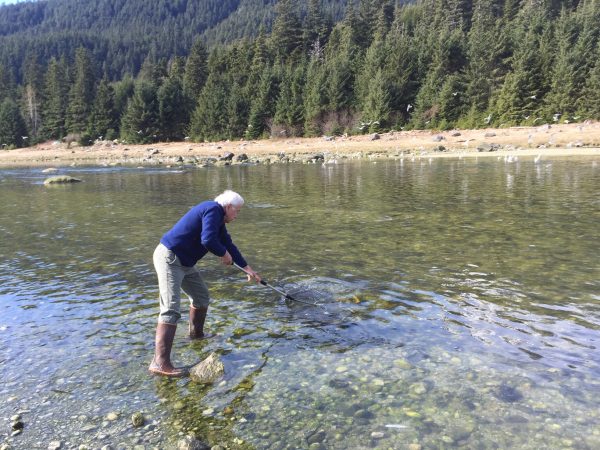
A record eulachon run just wrapped up in Haines. They’re an oily smelt fish that are known to run in just a few dozen rivers in Alaska. Yet little is known about this long-loved subsistence fish, locally known as hooligan. The only ongoing research on Southeast Alaska hooligan is the result of a nine-year study by the Chilkoot Indian Association.
Mike Binkie stands calf-deep in the Chilkoot River, bent over a plastic bucket and armed with small clippers. Small silver fish wriggle in water that’s milky with eggs.
But these fish aren’t to eat. Binkie and a small team are clipping their adipose fin, then letting them swim on upriver. They count each fish they clip.
“So every ten clips, we make a click,” Binkie said. “Then we write all those down and then they find out somehow through that way how many fish are in the river.”
Upriver, another team is netting fish and counting them, too. They count how many clipped fish they find, so they can extrapolate the total number of fish.
“Nobody knows these guys’ lifecycle,” Binkie said. “It’s kinda cool.”
But they’re working to find out.

“It’s a huge food source for these animals and for sea lions in particular. It’s a really vital piece of our whole ecosystem,” said Meredith Pochardt, director of the Takshanuk Watershed Council. “So, culturally we’re looking at this from the subsistence side, but also ecologically it’s a very important food source.”
That’s why the Takshanuk Watershed Council partnered with the Chilkoot Indian Association about a decade ago, to help them with their hooligan study. The aim of the study is pretty simple: to figure out how many hooligan are running in the Chilkat Valley each year. It’s a first step to learning more about the fish. The Alaska Department of Fish and Game completed a eulachon study in 2002, but left many questions unanswered.
“Prior to 2010, there was zero population data for northern Lynn Canal,” Pochardt said. “And so, that was why the study started. Is just to gather that baseline data.”
Back then, NOAA fisheries had just declared the hooligan a threatened species down south. They’re protected under the Endangered Species Act from British Columbia to Northern California. That designation prompted the Chilkoot Indian Association to start keeping track of the yearly hooligan returns.
The populations up here in the Upper Lynn Canal aren’t threatened. In fact, this year the team has counted a record number of fish. About 26 million.

Back on the Chilkoot, Klukwan resident Tony Strong is using a dip net to catch a few.
“That rock creates a small back eddy and that’s where the fish will come up and get a little rest,” he said. “That’s where I can capture them.”
Strong fills his net with a practiced hand. He’s been out in the water for awhile, but his clothes are still dry and clean. His mother and grandmother taught him how to harvest the fish when he was a little boy.
He’s filling three 15-gallon buckets. A couple of these buckets will be on a plane to family in Juneau this afternoon. The fish ran for about a week this year–a long run for hooligan. But Strong knows how to make the catch last all year.
“So we smoke it, we dry it, we freeze it, and various other things: eat right quick! It’s an acquired taste,” he said with a smile. “It’s delicious.”
He shields his eyes against the sun and waves at some friends on the bridge. Gulls sweep overhead, aiming for the dark parts of the river, where the water is black is fish.




